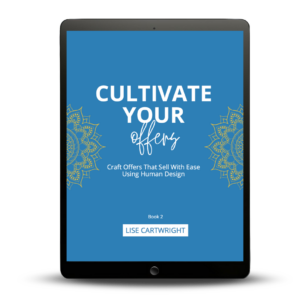When I’m thinking about creating something I can make and sell in my online business, I have an offer process that I go through.
Normally when I’m creating an offer, I sit down and ask myself who is the person that I know I can 100% help with this offer? What does that person look like? Are they working? What are they working on? What are they struggling with?
I have an entire process that I ask myself BEFORE I create an offer, and it takes about an hour to really hone in on what that ideal customer looks like, based on who I’m uniquely positioned to help.
My Offer Process Step-by-Step
Step 1: Identify The Result The Customer Will Achieve
The first thing I ask is: What is the very clear result that I’m trying to help people get to? I need to be really clear on that first. The result becomes my offer.
For example, when I was building out The Ask Sales Plan Bootcamp, this is how I started the process…
I was inspired to share my sales planning process because people in my FB Group were asking me lots of questions about the HOW of selling. My offer creating process started here.
Before I go any further though, I ask myself one very important question (two actually):
- Is this easy and fun for me to do?
- Do I feel equipped to teach on this right now?
If I get a resounding ‘HECK YES’ then I know I’m good to go.
Then I get clear on the RESULT I’m helping someone achieve, which for The Ask Sales Plan is: teaching someone the daily tasks needed to sell and make money in their online business every single day.
I’ll also practice sitting in JST, so I can brainstorm more ideas for my business. This allows me to get clear on what I’m focusing on and make sure I’m not doing something out of alignment with my business.
Step 2: Identify The Target Customer
Secondly, the next question in my offer creation process is: Who is the person that I am trying to help?
You might hear people talk about having your ideal target audience in mind all the time. I personally like to narrow it down even further and focus on a specific audience for EACH offer. That sub audience generally falls within my overarching target audience that I know I can serve.
When it comes to creating offers, it’s so much easier to only serve a subset of my audience. I understand that I can’t serve everyone all the time with everything I create.
And that’s okay. Because I would rather speak to the people who are ready to take that next step than try to sell everyone on everything that I have.
So when I’m sitting down and coming up with amazing ideas that I feel energetically behind and I’m excited to do them, I’m asking who am I trying to help?
At the end of the day, if I can’t clearly articulate that, then there’s no point creating the offer. 
Because as amazing as the offer might be, if I don’t have a clear picture of the target person that I’m trying to get in front of, no one’s going to buy it. I might think it’s great but unless I actually have a very clear idea of who I’m going to serve with this particular offer, I’m not going to do it. It probably won’t sell and why waste time and energy on things that you can’t sell with ease?!
So for The Ask Sales Plan Bootcamp, the target customer I knew I could help looked like this:
- already has an online business
- is motivated to make CONSISTENT money
- wants to know how to ask her audience for the sale every day
- is willing to take action
- has an audience already
- has at least one offer ready to sell
Step 3: Identify How The Target Customer Struggles Getting to The Result
Thirdly, I ask: What are their struggles as it relates to the offer that I’m creating?
Again, in The Ask Sales Plan Bootcamp, I’ve identified that the target customer is probably struggling with:
- how to ask for the sale without feeling icky
- knowing what tasks to do daily that result in sales
- making consistent income in her business
- deciding what offers to present that result in sales
I know I can help them with that. I can anticipate where they might get stuck. 
Those three steps will get you started. There are more questions that you can ask, but really if you get through those three questions and you still don’t have a clear idea of who that customer is, then you need to stop and reassess. Go back to the drawing board and layout a different offer.
Why I don’t do this…
This is why I never, ever, ever 100% build out an offer ahead of time. I don’t ever sit down and think about an amazing thing that I want to create, create it and then figure out who my audience is. No, I don’t do that.
I DO have an outline. I don’t go in blind. But I allow the offer to fully take form as I learn more about my audience and what they need and want. They inspire me. That’s why when I recently had to re-record the Micro Offers Workshop (I experienced a technical glitch during the actual live delivery) and wasn’t in front of a live audience, it took less time than the live workshop. I wasn’t feeling and responding to the energy of the group. So if you ever get the chance to work with me live, you get a different experience.
With the workshops that I’ve been doing lately, they are created AFTER I have an audience identified. I don’t do anything ahead of time because unless I have people buying it, why would I create it? That would be wasted time. Even if I believe it’s an amazing offer if my audience doesn’t feel the same way, then why would I put time and effort into creating it?
It always circles back to what’s easy and what’s fun for me. And It gets to be that way for you too.
Now, this offer process might not be right for you. It depends on your personality type. You always get to decide what this process looks like for YOUR business.
If the thought of creating something two or three hours before it actually goes live freaks you out, then you do what makes the most sense for you.
Create What You Embody
When I talk about a business that’s easy and fun, it’s easy for me to create things that I 100% embody. Likewise, it’s fun for me to do things that come easily.
A big disconnect can be felt when you yourself aren’t experienced doing the thing that you’re offering and teaching.
So if you’re feeling anxious and nervous about selling this thing you haven’t done before, that’s a key indication that you shouldn’t do it. You might know it in theory, but unless you have first-hand experience don’t try to sell knowledge you don’t possess.
We can theoretically know something, but unless we have actually lived and breathed an experience, it’s extremely difficult to then be able to share and pass on that knowledge… unless you’re transparent about it being untested (which is great to get beta testers involved!). People can feel that. Your customer can feel that disconnect.
This is why I will never sell a course on dog training. I love dogs but don’t currently have one and have never trained one. While, theoretically, I probably could do a quick Google search and figure it out. But to turn around and actually teach on this… my audience would feel the disconnect.
When I was brainstorming The Ask Sales Plan Bootcamp, I knew I could help other business owners get comfortable asking for the sale because I’d felt uncomfortable around it too. Prior to January 2020, I often felt uneasy launching a new product or service. I’d worry about sounding salesy in my emails and that people would think all I wanted was money from them.
I spent a lot of time launching in fear instead of it being easy and fun… we often forget that we get to decide all of this!
For me, this entire offer process happens during JST. I use JST to get clarity in the decision-making process and highly recommend doing it for yourself.
I don’t always get everything right, but I know that when all of this stuff aligns, everything feels good and goes amazingly well. That’s why I’m constantly asking myself this question:
Is everything aligning and does it feel good?
Because again, why would I create a business that doesn’t feel good?
When I quit my job back in 2012 and went full-time as a freelance writer, for the first six months I loved it. After that, I started to get an inkling that it probably wasn’t the thing that I wanted to be doing long term. But I stayed doing that for at least another year and a half because I couldn’t figure out how to get out. I thought it was something I HAD to keep doing. I didn’t know what my next step was.
Once I figured out that I needed to change my offer from freelancing to coaching… that felt like a better fit for me.
It’s a weekly process
For me, every Friday I sit down and review what I have planned for the next week. I ask myself if I’m still going to do those things. And it’s okay if it changes. Easy and fun are what I’m looking for, and everything passes through that filter.
So always have an awareness to figure out what makes the most sense for YOU and your business and then follow that path. It starts with internally questioning everything and having a process to be constantly reviewing regularly.
This is how you ensure your business is easy and fun.
Action Step:
Set aside some time for JST with a notebook and pen nearby.
- What offers do you feel inspired to create?
- What problem does each offer solve?
- Who is the ideal subset customer for each offer?
And don’t be afraid to ask your email list, audience, or Facebook group, etc. what they want next. That practically guarantees sales.
If you want to dive into this process even deeper, my book, Cultivate Your Offers is a great next step.
You’ll discover an entire, step-by-step process on how to ensure you’re creating offers that your audience can’t wait to get their hands on!
Available in ebook and print format.
CLICK HERE TO GRAB YOUR COPY TODAY!

